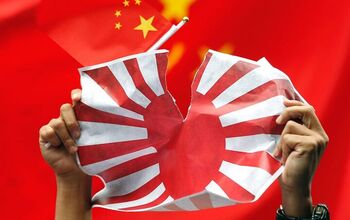Japanese Automakers: Sayonara, Japan

Japanese automakers will move their production elsewhere if the yen keeps rising. This is what Toshiyuki Shiga, chairman of the Japan Automobile Manufacturers Association, told The Nikkei [sub] in a very blunt interview. Shiga, who is also the COO of Nissan, said that power shortfalls and the strong yen are the biggest impediment to Japan’s most important industry.
The industry can work around the power shortages. Last weekend was the first when Japan’s automakers worked. They will instead take Thursday’s and Friday’s off, putting less strain on the grid. That system would work better if other industries would come to similar arrangements, but it works.
As far as the currency goes, the manufacturers can just watch and be sweat even more than what is caused by air-conditioning set to 82 F. Today, a dollar bought 80 yen. That won’t get you far in Japan. Not even to the next subway station.
Said the Chairman of Japan’s Automobile Manufacturers Association:
“It is strange that the government has allowed the yen to rise so high. Ever since automakers’ supply chain systems were damaged, the companies have been thinking about whether they should try to restore their supply chains to their pre-disaster conditions or instead turn to overseas suppliers.”
“It would not be surprising if some Japanese firms changed their procurement methods if things continue as they currently are.”
“No Japanese manufacturer can generate a profit from exports at an exchange rate of 80 yen to the dollar.”
“For years, Japanese carmakers collectively continued to turn out around 10 million vehicles domestically, and that did a lot to help keep the jobless rate from rising to the two-digit level. But people should not be so optimistic as to believe that automakers would never pull out of the home country.”
To make matters worse for the Japanese industry, a free-trade agreement between South Korea and the EU just took effect, helping Hyundai and Kia even more. The Japanese government could end its foot-dragging at least on that front.
As far as the currency goes, the governmental hands are pretty much tied. The oldest trick in the book is to lower interest rates. If Japanese interest rates would go any lower, you would have to pay the bank for taking your money. Quantitative easing? Japan invented quantitative easing, and look what that did to their currency.
Think about it: Here is a country that never recovered from the crash following the big 1990s bubble. It was hit by what some say was the force of a thousand times the power of all nuclear bombs on earth. Yet, people around the world are buying its currency. Makes you wonder about what’s going on around the world.

Bertel Schmitt comes back to journalism after taking a 35 year break in advertising and marketing. He ran and owned advertising agencies in Duesseldorf, Germany, and New York City. Volkswagen A.G. was Bertel's most important corporate account. Schmitt's advertising and marketing career touched many corners of the industry with a special focus on automotive products and services. Since 2004, he lives in Japan and China with his wife <a href="http://www.tomokoandbertel.com"> Tomoko </a>. Bertel Schmitt is a founding board member of the <a href="http://www.offshoresuperseries.com"> Offshore Super Series </a>, an American offshore powerboat racing organization. He is co-owner of the racing team Typhoon.
More by Bertel Schmitt
Latest Car Reviews
Read moreLatest Product Reviews
Read moreRecent Comments
- MaintenanceCosts Nobody here seems to acknowledge that there are multiple use cases for cars.Some people spend all their time driving all over the country and need every mile and minute of time savings. ICE cars are better for them right now.Some people only drive locally and fly when they travel. For them, there's probably a range number that works, and they don't really need more. For the uses for which we use our EV, that would be around 150 miles. The other thing about a low range requirement is it can make 120V charging viable. If you don't drive more than an average of about 40 miles/day, you can probably get enough electrons through a wall outlet. We spent over two years charging our Bolt only through 120V, while our house was getting rebuilt, and never had an issue.Those are extremes. There are all sorts of use cases in between, which probably represent the majority of drivers. For some users, what's needed is more range. But I think for most users, what's needed is better charging. Retrofit apartment garages like Tim's with 240V outlets at every spot. Install more L3 chargers in supermarket parking lots and alongside gas stations. Make chargers that work like Tesla Superchargers as ubiquitous as gas stations, and EV charging will not be an issue for most users.
- MaintenanceCosts I don't have an opinion on whether any one plant unionizing is the right answer, but the employees sure need to have the right to organize. Unions or the credible threat of unionization are the only thing, history has proven, that can keep employers honest. Without it, we've seen over and over, the employers have complete power over the workers and feel free to exploit the workers however they see fit. (And don't tell me "oh, the workers can just leave" - in an oligopolistic industry, working conditions quickly converge, and there's not another employer right around the corner.)
- Kjhkjlhkjhkljh kljhjkhjklhkjh [h3]Wake me up when it is a 1989 635Csi with a M88/3[/h3]
- BrandX "I can charge using the 240V outlets, sure, but it’s slow."No it's not. That's what all home chargers use - 240V.
- Jalop1991 does the odometer represent itself in an analog fashion? Will the numbers roll slowly and stop wherever, or do they just blink to the next number like any old boring modern car?






























Comments
Join the conversation
Things are looking bleak for Japan - some suggest they could be in for a third "Lost Decade": http://www.theglobeandmail.com/report-on-business/international-news/asian-pacific/japan-could-face-a-third-lost-decade/article2076733/ As pointed out, the government doesn't really have any levers to pull to lower the currency at this point - after dropping throwing money from helicopters for 20 years there's not much else that can be done in the near future. The June sales figures posted earlier show us that many in America (arguably Japan's most important market) have moved to Domestic or Korean cars. At least some of those lost customers will have good ownership experiences, and won't be back.